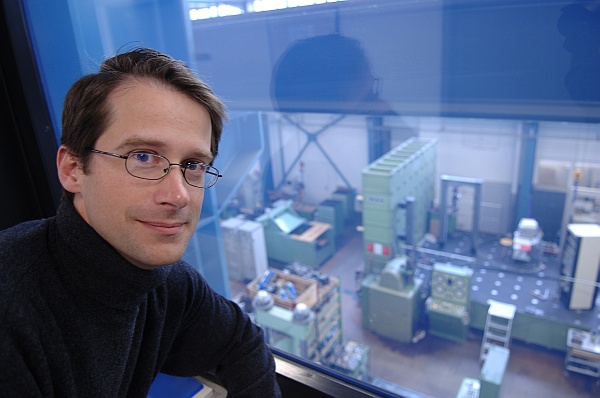|
Legend: As Head of the Materials and
Engineering Section, Dr. Giovanni Terrasi is confident of meeting
the ambitious targets with the support of his team. Home to the
section is the «metal shed», pictured in the
background, at Empa's Dübendorf site.
In his capacity as head of research and development, engineering
and quality assurance at structural fabricator SACAC AG in
Lenzburg, Ticino-born Terrasi demonstrated his ability to translate
innovative research ideas into marketable products. At SACAC,
Terrasi and his team managed to produce heavily constructed
elements from self-compacting high-performance concrete and create
new products using filigree, corrosion-resistant,
carbon-fibre-prestressed concrete sections. He now intends to
exploit his in-depth knowledge of composites and engineering, honed
through several years of practical experience in a production
facility, to intensify the Materials and Engineering Section's
collaboration with industry.
Materials and Engineering remit
Formed in April 2005, this relatively new Empa section
carries out innovative projects in the following research and
development areas:
Smart structures
New materials capable of serving as actuators and/or
sensors are used to develop smart structures which lend themselves
to mechanical engineering, transport or medical applications.
Active fibre composites (AFC) and electroactive polymers (EAP)
represent two focal technologies. The section's aim is to build
interesting prototypes and technology demonstrators, such as a
six-metre-long EAP blimp to be developed over the next two years.
This is designed to showcase the bionics-inspired undulating
locomotion concept – similar to the flapping action of a fish
in water – to the expert community and a wider audience. This
type of low-noise airship would be ideally suited for carrying
television equipment, e.g. for sports transmissions. Moreover, a
single airship of this kind would offer the capacity to handle all
mobile phone calls in the London conurbation, thereby making
countless radio masts redundant.
Biomedical engineering
Here, research centres on the mechanical performance of newly
developed biocompatible products, biomaterials and surgical
implants. Partnered by industry, the section works on improving
orthopaedic components. Specific projects have focused on the
application of the finite element method in optimizing the design
of an intervertebral disc replacement, in collaboration with
implant manufacturer Synthes, and the development of a simplified
spine simulator for vibration durability testing under real ambient
conditions. New projects involving Terrasi's team and other Empa
departments will investigate the application of hard,
long-term-stable carbon surface layers to artificial joints. The
section is also collaborating with colleagues at Empa in St. Gallen
in the design of innovative hip protectors for the elderly using
fibre composites and polymer foams.
Composites
In addition to the industry-oriented development of components and
experimental checks on elements and prototypes, activities in the
field of composites focus on materials engineering innovations: one
new research project deals with the use of nanoparticles to
increase the fracture toughness of epoxy. A composite comprising
clay nanoparticles and carbon nanotubes in an epoxy matrix for
glass- or carbon-fibre-reinforced laminates is intended to enhance
the impact strength and fire resistance of fibre composites.
Mechanical structures
The impact of static and/or dynamic loads on mechanical
structures made of metal, polymers or composites is of crucial
importance in a wide variety of applications. The results of
related investigations serve both to demonstrate serviceability and
operational durability and to facilitate design improvements. Close
contacts with Swiss SMEs allow joint R&D projects to be
implemented in the fields of lightweight construction and
operational durability (e.g. involving the combination of fibre
composites with metal). The activities in this area make a major
contribution to the high standard of a services provided for Swiss
industry. These include surveys into failures such as the track
cable fracture on the Schilthorn cableway in December 2004, which
last year culminated in the preparation by Empa of new monitoring
regulations for aerial ropeway cables.
Complementary services
The Section's research and development activities continue to be
supplemented by an attractive range of top-notch technical services
for industry and the public sector. Examples include surveys into
the operational durability of aerial ropeway structures, monitoring
of the structural and prestressing steel providers operating in
Switzerland (SIA register), measurement of service loads acting on
transport vehicle components and sophisticated mechanical tests on
plastics piping systems.
Giovanni Terrasi's verdict so far: «After only two months in
the Section, I am very confident that, given the in-depth expertise
and unstinting commitment of the team, our work in the field of
materials and engineering for innovative devices can meet the
ambitious targets that have been set. We are in for a thrilling
time!»
|

